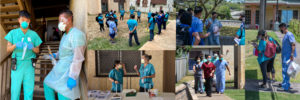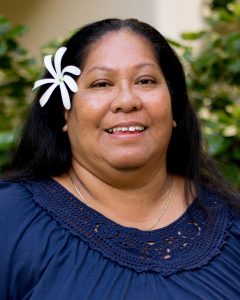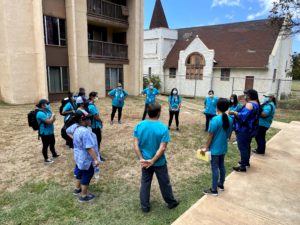
Photos courtesy of Hawaii National Guard
The pandemic has intensified the differences between the haves and the have-nots. Health and social disparities in Hawaii have become more pronounced. The Hawaii Department of Health, in collaboration with other government agencies and nonprofit organizations, is tackling this head on, and is an important part of an overall strategy to make sure everyone has access to care. Rather than being marginalized, low-income families and individuals have been a top priority in outreach and education efforts to keep everyone in the community healthy.
A Model of Effective Collaboration
Much of this outreach and education to low-income families in public affordable housing units is taking place behind the scenes without fanfare, but has been a shining example of collaboration among the Department of Health, the City & County of Honolulu, nonprofit organizations, and the federally qualified community health centers island wide. (The public health nurses on the neighbor islands take on a variety of responsibilities and this has continued during the pandemic.)
Outreach to those in public housing was the brainchild of Elizabeth MacNeill, MD, MPH, who has been serving in a dual role since the outset of the pandemic. She has stepped forward to be the Hawai‘i Department of Health’s liaison with the City & County of Honolulu for intergovernmental collaboration while continuing in her role as chief of the health department’s tuberculosis control branch.
“Although providing COVID information is paramount, residents have been impacted in other ways, too, including the loss of health insurance, unemployment and food insecurity,” Dr. MacNeill said. “We want to make sure they know how to access other resources to help with these issues too.”
She presented the need to DOH’s public health nursing team, which immediately saw the urgent need to reach out to this vulnerable group. Those who test positive and live in households with many family members may find it challenging to isolate themselves from others in their home. For many, English is their second language, creating another potential barrier to adhere to recommended guidance to manage the spread of the disease in their families. There is a need for practical, culturally sensitive information on what steps they can do to protect themselves, their family and the community.
It Takes a Village
“We immediately realized we cannot do t his alone. It takes a village,” said Gloria Fernandez, DNP, RN, PHNA-BC, quality assurance coordinator with the DOH’s public health nursing branch. “The collaboration has been wonderful, with everyone bringing their expertise together nicely and staying in their lane so that we’re not duplicating services. We respect each other’s boundaries…This is what it’s supposed to be like…I don’t want this collaboration to go away!”
his alone. It takes a village,” said Gloria Fernandez, DNP, RN, PHNA-BC, quality assurance coordinator with the DOH’s public health nursing branch. “The collaboration has been wonderful, with everyone bringing their expertise together nicely and staying in their lane so that we’re not duplicating services. We respect each other’s boundaries…This is what it’s supposed to be like…I don’t want this collaboration to go away!”
DOH has taken the lead in planning these efforts and has recruited the support of a number of partners, many of whom have taken on the outreach efforts on top of their usual job responsibilities. The partners include:
- Federal agencies such as the Hawaii National Guard Task Force;
- Numerous state agencies, including the Hawaii Public Housing Authority, the Hawaii Department of Health’s Communicable Disease and Public Health Nursing Division, Public Health Nursing Branch, Disease Outbreak Control Division, Bilingual Health Services in the Chronic Disease Prevention & Health Promotion Division, and Public Health Emergency Preparedness Program – Medical Reserve Corp.;
- The City & County of Honolulu’s Department of Emergency Management;
- Federally qualified health centers such as Kōkua Kalihi Valley, Kalihi-Palama, Kōkua Kalihi Valley Health Center and Waianae Coast Comprehensive Health Center;
- Low-income housing property management companies, including Mutual Housing Association of Hawaii and Michaels Management Services;
- Nonprofit organizations such as Parents And Children Together (PACT); and
- Churches such as St. Stephen’s Episcopal Church in Wahiawa.

It is a daunting project. On Oahu alone, there are 43 public housing properties with a total of 4,872 units that provide housing for an estimated 20,000 people. The teams have reached out to 14 of these properties representing more than 2,300 units, starting with Kalihi Valley Homes on May 15, 2020.
Other properties that have been visited include Palolo Valley Homes, Mayor Wright Homes, Kuhio Homes, and Kuhio Park Terrace Low-Rises Homes in the Kalihi-Palama area, Kauhale Nani and Wahiawa Terrace in Wahiawa, Kamehameha and Kaahumanu in Kalihi Valley, and Nanakuli Homes, Maili I, Maili II, Kauiokalani, and Waimaha Sunflower in the Waianae district.
 Another outreach event is scheduled for tomorrow, Friday, August 14, at Puuwai Momi in Aiea. The Hawaii National Guard lays the foundation for each visit. They select the sites and determine if it is better to conduct COVID-19 tests in the individual homes of a family or in a centralized area while honoring privacy. Testing is conducted on properties that are considered potential outbreak sites. The Medical Reserve Corps, which is composed of volunteer doctors, registered nurses and others, are responsible for swabbing to collect the specimens for tests that are sent to the DOH’s State Laboratories Division.
Another outreach event is scheduled for tomorrow, Friday, August 14, at Puuwai Momi in Aiea. The Hawaii National Guard lays the foundation for each visit. They select the sites and determine if it is better to conduct COVID-19 tests in the individual homes of a family or in a centralized area while honoring privacy. Testing is conducted on properties that are considered potential outbreak sites. The Medical Reserve Corps, which is composed of volunteer doctors, registered nurses and others, are responsible for swabbing to collect the specimens for tests that are sent to the DOH’s State Laboratories Division.
The Hawaii Public Housing Authority has played a key role in alerting public housing residents of upcoming visits and provides background information on the residents to the teams.
“With every adversity, there is opportunity for growth and change. We can either be beaten down by this pandemic or we can rise-up and come together as a community,” said Hawaii Public Housing Authority Executive Director Hakim Ouansafi. “Our staff report to work each day continuing to serve our public housing communities, as much of the essential work we do cannot be done from home, and the HPHA continues to honor our commitments and we will not stop looking for new opportunities to serve and care for our public housing communities.”
Reaching Beyond Public Housing
Dr. MacNeill added there are low-income families in areas surrounding public housing. The teams also reach out to these areas outside of public housing, such as Kahauiki Village, a homeless community, and Palolo Homes and other homes in Waipahu, Wahiawa and Waianae to make sure these families also receive attention and care.
The teams have also conducted outreach events at various Waipahu sites, including Aniani Place, Jack Hall Housing, Pupuole Park, Su Casa, and West Oahu Christian Church, as well as St. Stephen’s Episcopal Church in Wahiawa.
Opportunities for Education
Each visit is an ideal opportunity for education to model physical distancing and other protocols. It starts with making sure the family members who answer the door have masks. This leads to a simple survey to assess a family member’s understanding of pandemic and protocols to prevent COVID-19 and the spread of the disease.
“We’re not just distributing information flyers; we’re going door-to-door for face-to-face conversations. We talk to everyone who answers the door. We answer their questions and correct misinformation about the virus, isolation, quarantine, or how to care for kupuna,” Gloria said.
For many who live in public housing, English is a second language. The joint teams include interpreters for a wide range of languages and dialects, including Marshallese, Chuukese, Pohnpeian, Tagalog, Ilocano, Mandarin, Korean, Vietnamese, Laotian, Samoan and Tongan. The interpreters are offered by the DOH language access program, Hawaii Public Housing Authority, the federally qualified health centers, and nonprofit organizations such as PACT.
“We are truly grateful for the support of partners like the Department of Health, the National Guard, Kōkua Kalihi Valley, Michaels Management, Better Tomorrows, the Hawaii Public Housing Authority and a host of others who stepped up to care for the community,” said Ryan Kusumoto, president and CEO of PACT. “This pandemic is a reminder that our health is connected to one another. Our health is connected and thus caring for each other as a community will bring us closer to reducing this virus in the community. This collaboration is a great example of the power of aloha that exists in our community.”
Gloria noted that the outreach helps to erase stereotypes that those who live in public housing do not work. On the days the teams arrive for canvassing, many residents will apologize that they have to go to work and cannot be home for the survey but will ask questions about the pandemic to learn how to protect themselves, their family and the community.
Healthcare Access
If family members do not have health insurance or a primary care provider, the team points them to the federally qualified health centers such as Kōkua Kalihi Valley, Kalihi-Palama Health Center and Waianae Coast Comprehensive Health Center. Eligibility workers are available to help with family members sign up for Med-QUEST health plan. Public housing residents can also learn about the services offered by a federally qualified health center and make appropriate appointments for care.
“The outreach efforts to families in public housing have been one of the bright spots of the pandemic response efforts in our state,” said Dr. David Derauf, executive director of Kōkua Kalihi Valley, a federally qualified health center that serves the Kalihi community and its large immigrant population. “The progress we’ve made in a relatively short time is the result of the community’s collaborative efforts. This has shown we can be effective when we all pull together as one team and have voices that are typically marginalized front and center at the planning table.”
Down to a Science
Depending on the size of the properties, there may be three to 10 teams deployed to canvass an entire property. They are equipped with two-way radio systems to stay in touch with each other throughout their visit, which is important for properties with a large footprint.
“We have it down to a science,” Gloria said. The teams have a half-hour pre-meeting and have a two-hour debriefing, and can typically cover the door-to-door visits at a site within three hours.
The number of units visited and the number of people the teams spoke with are captured to track the team’s effectiveness. The aggregated, real-time data is freely shared among the various participating agencies and the information is also posted on the Hawaii Public Housing Authority website: https://www.hphaishereforyou.org.
Mahalo to all of the teams for their collaborative efforts to keep everyone in Hawaii safe!
Denby Fawcett: Why So Few People Are Getting The New Covid Shot
Experts are worried about the lack of interest as people are still suffering from the virus and long Covid. By Denby Fawcett Original article on Civil Beat, November 7, 2023 I keep a card in my [...]
Federal Public Health Emergency (PHE) for COVID-19 ends on May 11, 2023
HONOLULU, HI –The federal Public Health Emergency (PHE) for COVID-19, declared under Section 319 of the Public Health Service Act, will expire at the end of the day on May 11, 2023. As the PHE [...]
Seniors now eligible for additional COVID-19 bivalent booster dose, COVID vaccine recommendations simplified
HONOLULU, HI – The Hawai‘i Department of Health (DOH) supports the latest recommendations announced yesterday by the Centers for Disease Control and Prevention (CDC), allowing an additional dose of the bivalent booster against the virus [...]
Hawai‘i COVID-19 hospitalizations on the rise
HONOLULU, HI – The Hawai‘i Department of Health (DOH) reports a rise in the rate of COVID-19 hospitalizations. The number of total positive COVID-19 hospitalizations has increased over the past week (3/26 – 4/4) from [...]
Wastewater Samples Show Higher COVID Concentrations & New Subvariant
The Hawai‘i State Department of Health’s most recent Wastewater Surveillance Report documents two significant developments about COVID-19 in Hawai‛i. Higher concentrations of the virus that causes COVID-19 The arrival of the XBB.1.5 subvariant Higher concentrations [...]
Bivalent boosters for keiki as young as 6 months
Updated COVID-19 bivalent boosters are now available in all counties for keiki as young as six months of age. The U.S. Food and Drug Administration (FDA) amended the emergency use authorization for the bivalent boosters [...]
